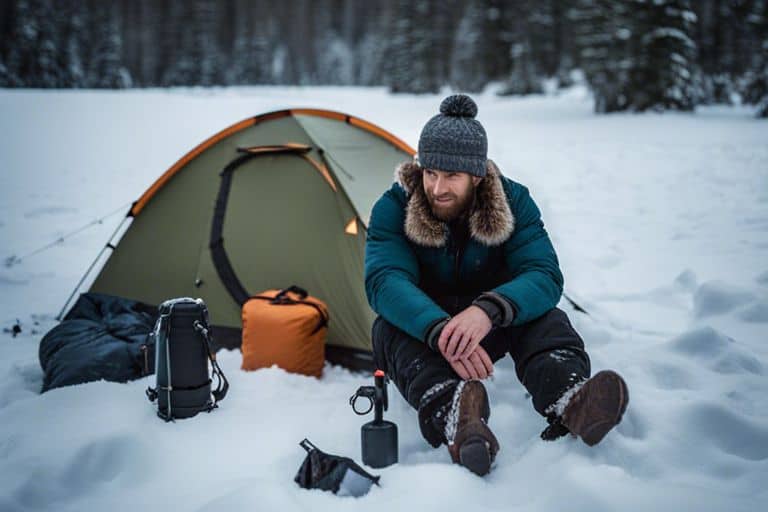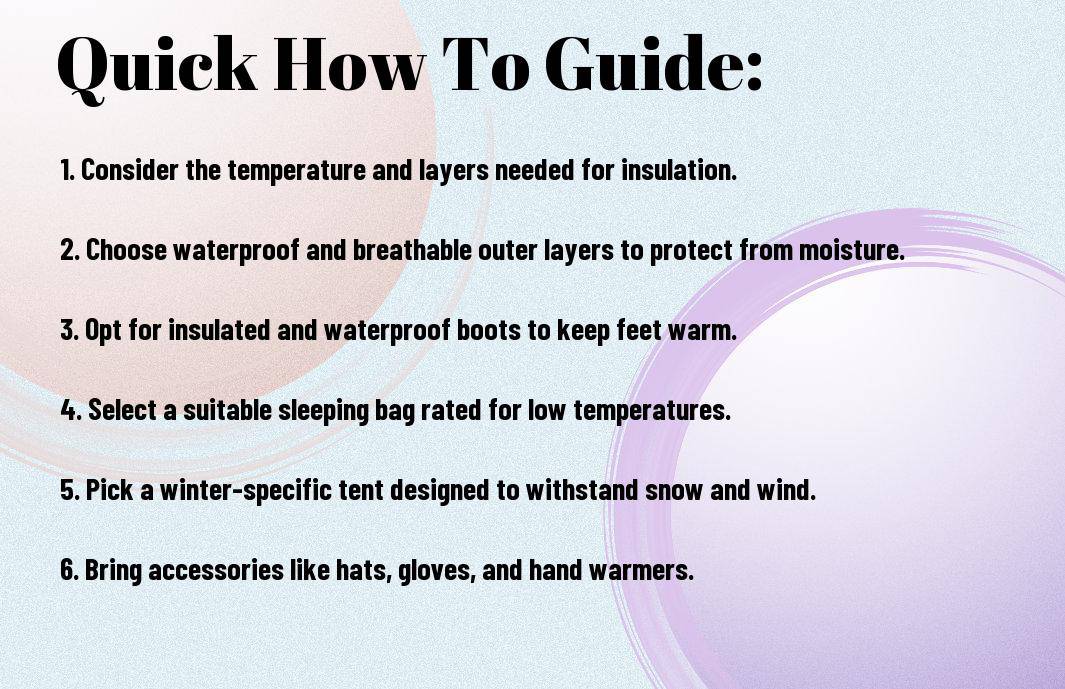You’re embarking on a winter camping trip in the midst of snowy conditions, and it’s crucial to have the right gear to ensure a safe and enjoyable experience. Winter camping can be a rewarding and invigorating adventure, but it also comes with its own set of challenges and risks. From frigid temperatures and heavy snowfall to potential avalanche hazards, your gear choices can make all the difference in how well you fare in the wilderness.
First and foremost, your shelter and insulation are paramount in snowy conditions. A sturdy, four-season tent or a well-insulated, cold-weather sleeping bag can mean the difference between a cozy night’s sleep and a dangerous battle against hypothermia. Similarly, proper layering and waterproof clothing are essential to keep you warm and dry as you navigate the wintry landscape. Your footwear also plays a critical role in keeping you safe and comfortable while trekking through snow, so invest in quality, insulated boots with good traction. By carefully selecting the right gear for winter camping, you can ensure that you’re prepared for whatever the snowy wilderness throws your way.
Contents
Key Takeaways:
- Understanding the Conditions: Before choosing gear for winter camping in snowy conditions, it’s important to understand the specific environmental factors you’ll be facing, such as temperature, wind, and snowfall levels.
- Invest in Quality Insulation: Quality insulation is crucial for staying warm in snowy conditions. Look for down or synthetic fill in sleeping bags and jackets, and consider investing in a high-quality sleeping pad for insulation from the cold ground.
- Waterproof and Breathable Outerwear: When choosing outerwear for winter camping, prioritize waterproof and breathable materials to keep out moisture from snow and sweat, while allowing excess heat and moisture to escape.
- Traction Devices: Snowy and icy conditions require reliable traction to prevent slipping and falling. Consider investing in crampons or traction devices for your boots, as well as trekking poles for added stability on slippery terrain.
- Emergency Supplies: In snowy conditions, it’s crucial to be prepared for the unexpected. Pack emergency supplies such as a first aid kit, extra food and water, a navigation device, and a means of communication in case of emergencies.


Understanding the Winter Camping Environment
Some of the most enjoyable camping experiences can be had during the winter, particularly in snowy conditions. However, it is essential to understand the unique challenges and conditions that come with winter camping to ensure a safe and enjoyable trip. In this chapter, we will explore the key factors to consider when preparing for winter camping in snowy environments.
Weather Conditions and Variability
When camping in snowy conditions, you must be prepared for a wide range of weather conditions and variability. You could encounter anything from clear, sunny skies to heavy snowfall, strong winds, and rapidly changing temperatures. It is important to be equipped for these variations and to closely monitor weather forecasts before and during your trip. Your ability to adapt to changing weather conditions will be crucial for a safe and enjoyable winter camping experience.
Terrain and Snow Characteristics
The terrain and snow characteristics of your camping area will have a significant impact on your camping experience. Snow can vary greatly in terms of depth, density, and stability, and understanding these factors is important for both travel and shelter considerations. Additionally, the terrain itself, such as steep slopes or dense forests, can present challenges that you must be prepared to navigate. It is essential to thoroughly research and assess the terrain and snow characteristics of your chosen camping location to ensure your safety and comfort during your trip.
How to Choose the Right Shelter
Keep in mind that choosing the right shelter for winter camping in snowy conditions is crucial to ensure your safety and comfort. Your shelter will protect you from the harsh weather and provide a warm and secure space to rest and sleep. Here are some key factors to consider when choosing the right shelter for your winter camping trip.
Factors Affecting Shelter Choice
When selecting a shelter for winter camping in snowy conditions, there are several factors that will influence your decision. These include weather conditions, weight, size, and durability of the shelter. Additionally, the terrain and length of your trip will also play a role in determining the most suitable shelter for your needs. Portability and ease of setup are also important considerations, especially when dealing with heavy snow and freezing temperatures. Perceiving and understanding these factors will help you make an informed decision when it comes to selecting the right shelter for your winter camping adventure.
Tips for Tent Selection and Setup in Snow
When it comes to selecting and setting up a tent for winter camping in snowy conditions, there are a few important tips to keep in mind. Firstly, choose a tent specifically designed for winter camping with a sturdy frame and a snow skirt to prevent snow from accumulating inside. Additionally, consider a four-season tent that can withstand heavy snow loads and harsh winds. When setting up your tent in the snow, make sure to clear the ground of snow and create a level base to prevent melting snow from pooling inside. Recognizing these tips will help ensure a safe and comfortable camping experience in snowy conditions.
Selecting the Proper Sleeping System
Now that you’ve chosen the right winter camping tent, it’s time to focus on your sleeping system. A proper sleeping system is essential to staying warm and comfortable in snowy conditions. In this chapter, we’ll discuss the key elements to consider when selecting the right sleeping system for winter camping.
Insulation and R-Value Considerations
When camping in snowy conditions, insulation is crucial to staying warm throughout the night. Look for sleeping pads and sleeping bags with a high R-value to provide adequate insulation from the cold ground. R-value measures a material’s resistance to heat flow, with higher values indicating better insulation. Pay attention to the R-value ratings of both your sleeping bag and sleeping pad to ensure they are suitable for winter camping.
Sleeping Bag Types and Temperature Ratings
Choosing the right sleeping bag for winter camping involves considering the type of insulation as well as the temperature rating. Down and synthetic are the two main types of insulation, each with its own pros and cons. Down is lightweight and highly compressible, making it ideal for cold conditions, while synthetic retains its insulation properties when wet. When it comes to temperature ratings, remember that your bag’s rating is a survival rating, not a comfort rating. Assume that a rating of 0 degrees means you will survive at 0 degrees, not that you will be comfortable at that temperature. Be sure to check the manufacturer’s recommendations and consider your own cold tolerance when choosing a temperature rating.
| Type of Insulation | Pros/Cons |
|---|---|
| Down | Lightweight, highly compressible |
| Synthetic | Retains insulation when wet |
| Temperature Ratings | Survival rating, not comfort rating |
The Role of Sleeping Pads in Winter Comfort
Don’t underestimate the importance of a quality sleeping pad when winter camping. Sleeping pads provide insulation and cushioning from the cold ground, enhancing your overall comfort and warmth. Look for pads with a high R-value to effectively insulate you from the snow. Additionally, consider the pad’s thickness and size to ensure optimal comfort throughout the night.
Essential Clothing for Winter Camping
For winter camping in snowy conditions, choosing the right clothing is crucial for your safety and comfort. In order to stay warm, dry, and protected from the elements, it’s important to understand the essential clothing you will need for your outdoor adventure.
Layering Principles for Warmth and Moisture Management
When it comes to clothing for winter camping, layering is key. Layering allows you to adjust your clothing to regulate body temperature and manage moisture effectively. The base layer should be moisture-wicking to keep sweat away from your skin, the mid layer should provide insulation, and the outer layer should be waterproof and windproof to protect you from the elements. You can add or remove layers as needed to stay comfortable throughout the day.
Recommendations for Winter-Appropriate Fabrics
Choosing the right fabrics for your winter camping clothing is essential. Look for merino wool or synthetic materials for your base layer, as they are excellent at wicking moisture away from your skin. For insulation, down or synthetic insulation are both good options. When it comes to the outer layer, make sure it is made of Gore-Tex or a similar waterproof and breathable material to keep you dry and protect you from the wind.
Key Accessories: Gloves, Hats, and Footwear
In addition to your clothing layers, don’t forget to pay attention to your accessories. Your extremities are the most susceptible to cold, so invest in insulated, waterproof gloves and a warm, moisture-wicking hat to protect your head. For footwear, insulated, waterproof boots with good traction are essential to keep your feet warm and dry while navigating snowy terrain.
Winter-Specific Camping Gear
Not all camping gear is suitable for winter conditions. When camping in snowy conditions, it’s important to have the right gear to keep you safe and comfortable. Winter-specific camping gear is designed to withstand cold temperatures, protect you from the elements, and provide essential support in challenging terrain. In this section, we will discuss the importance of having snow-specific equipment and provide examples of essential gear for winter camping.
Importance of Having Snow-Specific Equipment
When you’re camping in snowy conditions, having the right gear can be a matter of life or death. Snow-specific equipment is designed to provide you with the necessary tools to navigate and survive in the snow. Having the right gear can help prevent cold-related injuries such as frostbite and hypothermia, while also providing stability and support on slippery and uneven terrain. Snow-specific equipment includes insulated clothing, snowshoes, ice axes, and snow shovels, all of which are essential for winter camping.
Examples of Snow Shovels, Snowshoes, and Ice Axes
When it comes to snow-specific equipment, snow shovels, snowshoes, and ice axes are indispensable tools for winter camping. Snow shovels are essential for clearing snow around your campsite, creating a path to your tent, and digging snow pits for shelter or storage. Snowshoes provide flotation and traction on deep snow, allowing you to navigate through snowy terrain with ease. Meanwhile, ice axes are crucial tools for self-arresting in case of a fall on steep slopes and for creating anchors in snow and ice for mountaineering or winter camping.
Nutritional and Hydration Needs
Unlike summer camping, the winter camping experience requires a shift in your nutritional and hydration strategy. The cold weather and physical activity demand more energy and water intake to keep your body warm and hydrated.
Adjusting Food and Water Supply for Cold Weather
When you’re camping in the snow, you need to increase your caloric intake to keep your body warm. Your body burns more calories in cold weather to regulate your core temperature, so pack high-energy foods such as nuts, dried fruits, and energy bars. In addition, you’ll need to drink more water to stay hydrated. The dry air and increased respiratory rate due to exertion can dehydrate you quickly, so be sure to bring a thermos for hot beverages and an insulated water bottle to prevent your supply from freezing.
Tips for Cooking and Storing Food in the Snow
When cooking in snowy conditions, it’s important to use a camp stove rather than a traditional campfire, as it’s easier to control the cooking temperature. Keep your fuel canisters and stove warm by storing them inside your jacket or sleeping bag when not in use. Store your food in sealed containers to protect it from getting wet or attracting wildlife. The freezing temperatures can work in your favor for storing perishable foods such as meats and dairy, but be sure to keep them in airtight containers to prevent them from getting contaminated by snow and ice. The last thing you want is food poisoning from improperly stored food in the snow.
- Use insulated food containers to keep hot foods warm.
- Minimize condensation in your food storage by wrapping food items in waterproof packaging.
The key to successful winter camping is maintaining a high energy level and staying well-hydrated. Whether you’re adjusting your food supply to account for the increased caloric needs or taking precautions to cook and store your food safely in the snow, prioritize these aspects of your winter camping experience for a safe and enjoyable trip.
Safety Considerations and Emergency Preparedness
To ensure a safe and enjoyable winter camping experience in snowy conditions, it is crucial to consider potential safety hazards and be prepared for emergencies. Your safety should always be your top priority when venturing into the wilderness during winter.
When navigating through snowy terrain, visibility can be significantly reduced, and it’s easy to become disoriented. You may encounter challenging conditions such as whiteouts or varying snow depths that can make it difficult to find your way. To mitigate these navigational challenges, it’s essential to carry a map and compass, and ideally a GPS device to help you stay on course. Additionally, familiarize yourself with the area’s topography before your trip and consider using landmarks to aid in navigation. It’s also a good practice to leave a detailed trip plan with someone you trust in case you encounter unexpected challenges.
Hypothermia and Frostbite Prevention
Exposure to cold temperatures can lead to serious health risks such as hypothermia and frostbite. It’s important to dress appropriately for the conditions and to layer your clothing to maintain warmth. Always pack extra clothing to change into if your current layers become wet. When camping in the snow, prioritize keeping your extremities such as hands, feet, and face well-insulated to prevent frostbite. Be vigilant for the early signs of hypothermia, including shivering, confusion, and slurred speech, and take immediate action to warm up if you notice any of these symptoms.
Creating a Winter Camping Emergency Kit
As part of your emergency preparedness, putting together a well-stocked emergency kit is essential. Your kit should include items such as a first aid kit, a multi-tool, headlamp or flashlight with extra batteries, fire-starting supplies, extra food and water, and a lightweight emergency shelter. Ensure that each member of your group carries their own basic survival supplies, and be familiar with how to use each item in your kit. Your emergency kit can be a lifeline in unforeseen circumstances, so make sure it’s comprehensive and easily accessible at all times.
Conclusion
Hence, it is crucial to carefully consider the gear and clothing you will bring with you on a winter camping trip in snowy conditions. Your choice of gear will directly impact your safety and comfort during the trip, so make sure to do thorough research on the best options for your specific needs. Remember to prioritize items that will keep you warm and dry, such as a quality down jacket, insulated sleeping pad, and waterproof boots.
Additionally, it is important to invest in high-quality, durable gear that will withstand the harsh conditions of winter camping. Look for gear that is specifically designed for cold weather camping, as it will likely provide the insulation and protection you need. By choosing the right gear for your winter camping trip, you can ensure a successful and enjoyable experience in the snowy outdoors.
FAQ
Q: What gear is essential for winter camping in snowy conditions?
A: Essential gear for winter camping in snowy conditions includes a four-season tent, a warm sleeping bag rated for low temperatures, a sleeping pad with a high R-value for insulation, layered clothing, waterproof and insulated boots, trekking poles, a stove and fuel, a reliable headlamp, and a navigation device like a GPS or map and compass.
Q: How do I choose the right winter camping tent?
A: When choosing a winter camping tent, look for a four-season tent with a geodesic or dome shape for stability in windy and snowy conditions. Ensure it has a waterproof and durable outer fabric, a good ventilation system to reduce condensation, and a solid pole structure to withstand heavy snow loads. Consider the capacity, weight, and ease of setup as well.
Q: What should I consider when selecting clothing for winter camping in the snow?
A: When selecting clothing for winter camping in snowy conditions, prioritize moisture-wicking and insulating layers. Look for breathable and waterproof outer shells, insulating mid-layers, and moisture-wicking base layers. Ensure your clothing provides freedom of movement and comfort while keeping you warm and dry. Don’t forget accessories like gloves, hats, and neck gaiters to protect extremities from the cold.


0 Comments